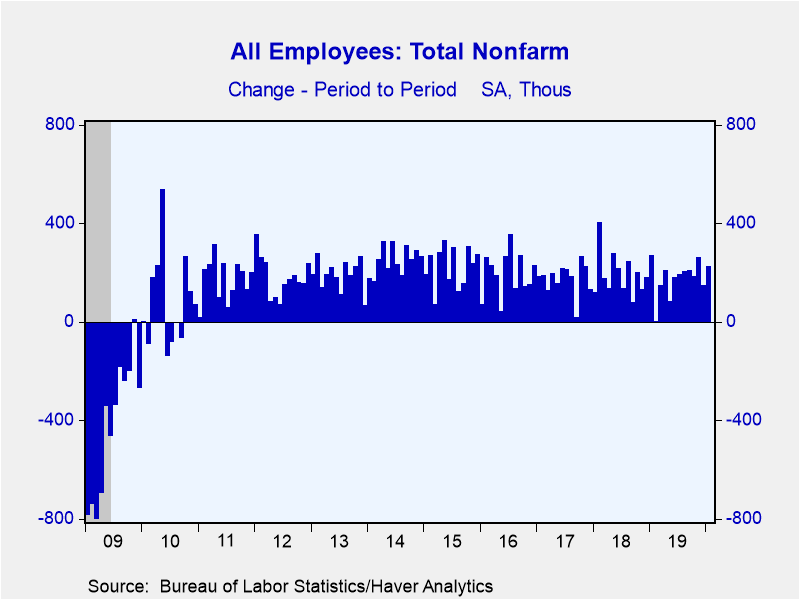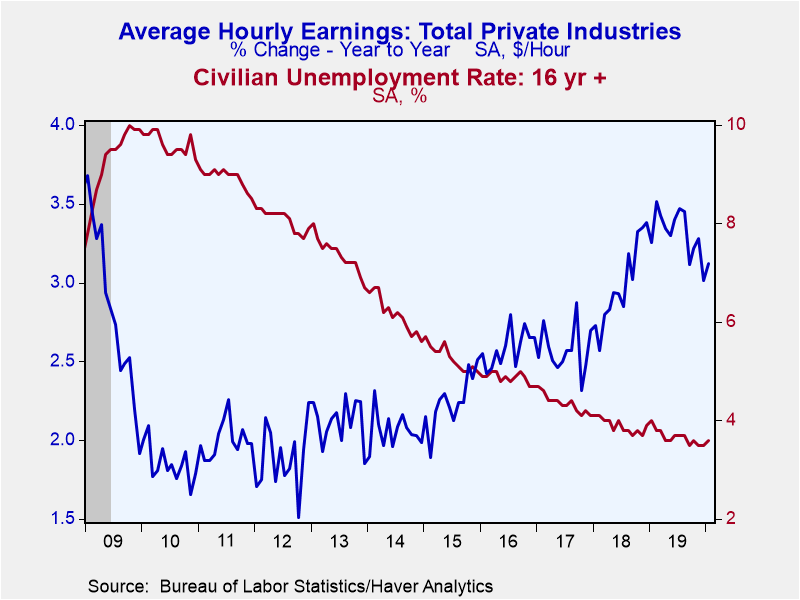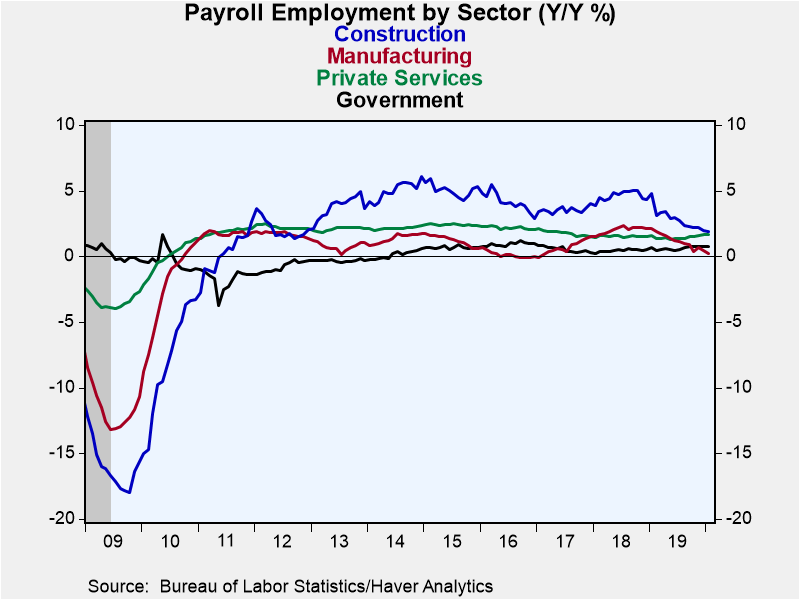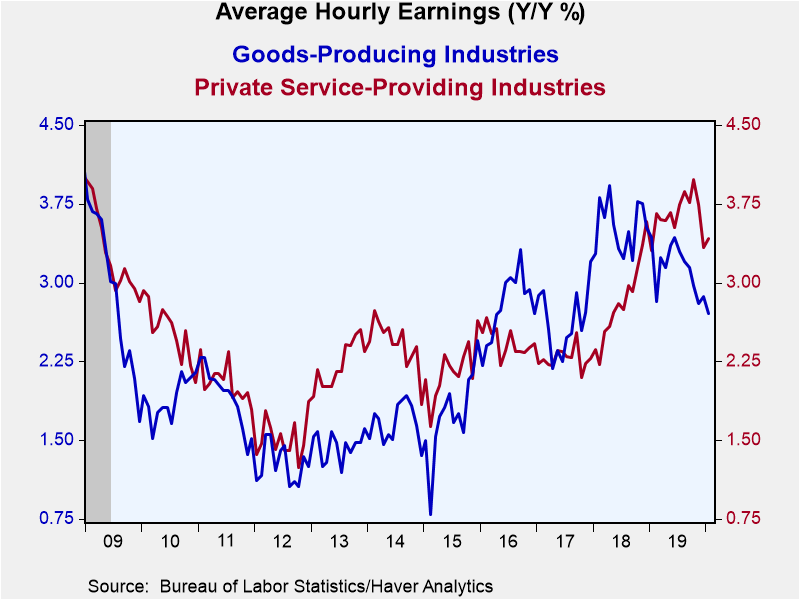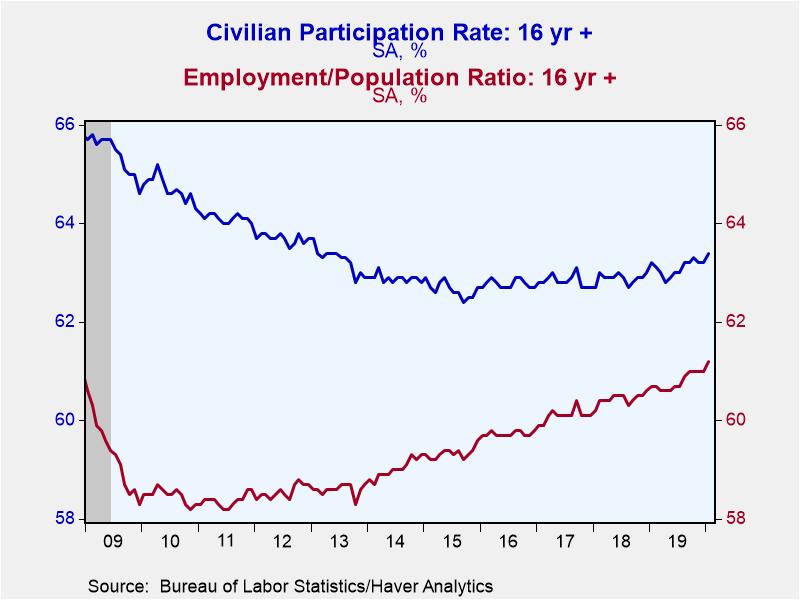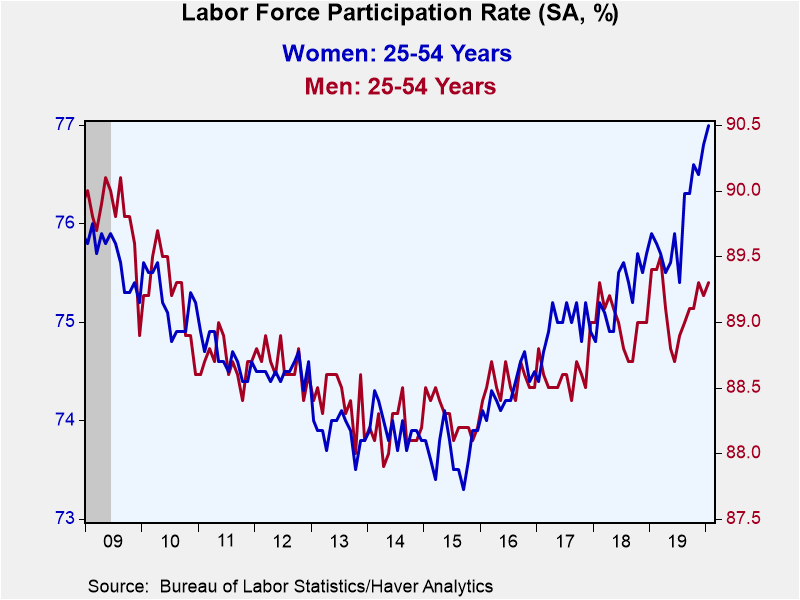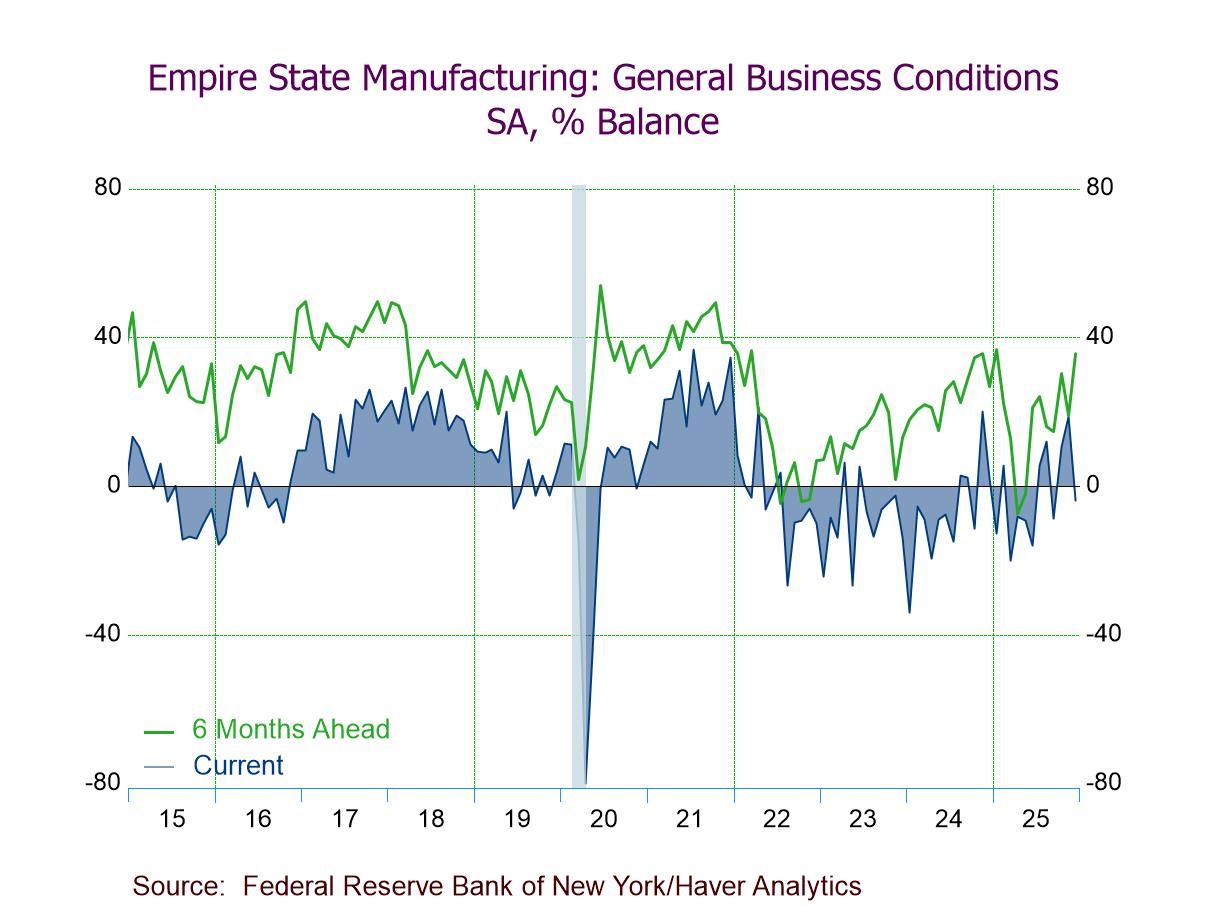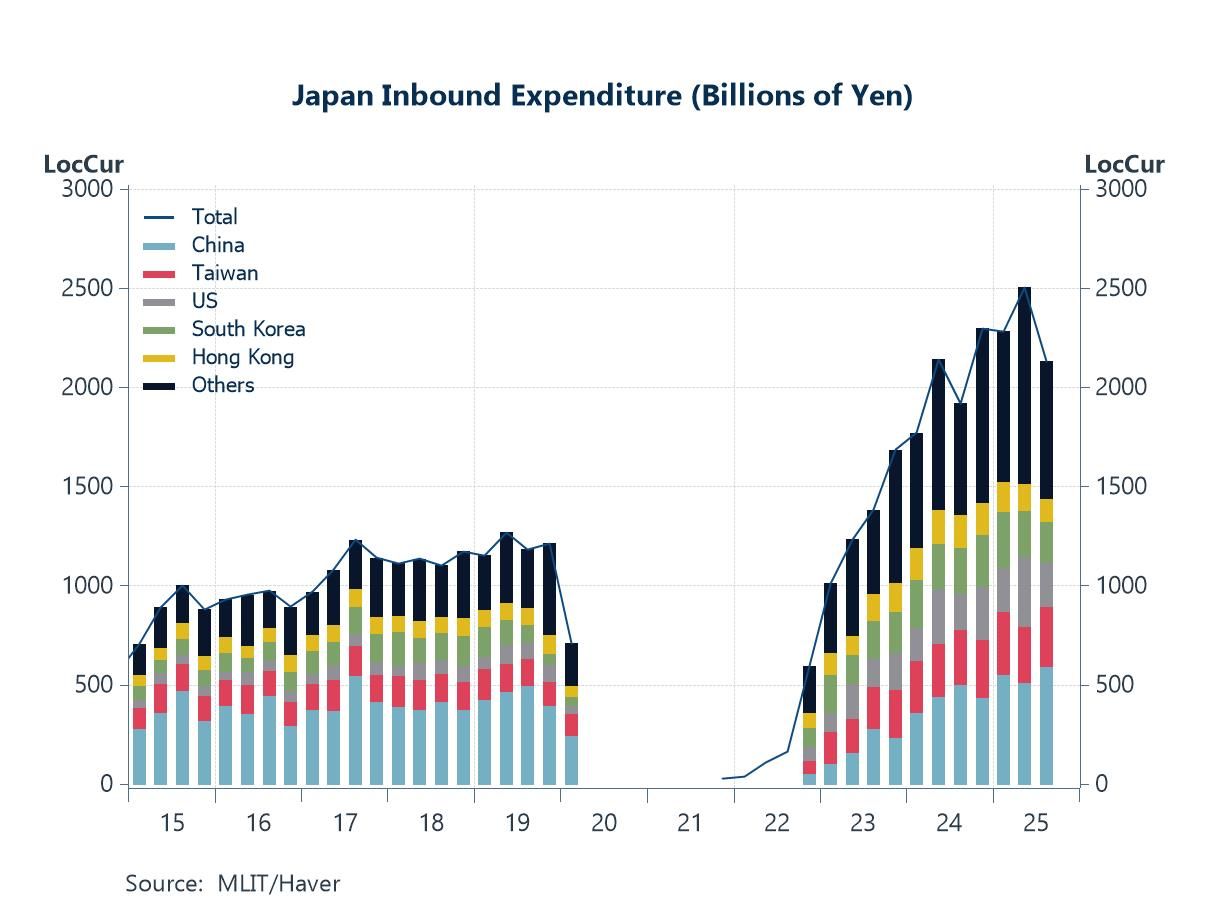 Global| Feb 07 2020
Global| Feb 07 2020U.S. Nonfarm Payrolls & Wages Improve; Unemployment Edges Higher
by:Tom Moeller
|in:Economy in Brief
Summary
The labor market strengthened as the new year began. Nonfarm payroll employment during January increased 225,000 (1.5% y/y) after rising 147,000 in December, revised from 145,000. November employment rose 261,000, revised from [...]
The labor market strengthened as the new year began. Nonfarm payroll employment during January increased 225,000 (1.5% y/y) after rising 147,000 in December, revised from 145,000. November employment rose 261,000, revised from 256,000. A 163,000 increase had been expected in the Action Economics Forecast Survey.
Average hourly earnings in the private sector improved 0.2% following an unrevised 0.1% December uptick. A 0.3% rise had been expected. Growth during the last twelve months of 3.1% remained below the recent 12-month peak of 3.5% reached in February of last year.
The unemployment rate rose to 3.6% in January. Stability at 3.5% had been expected. Employment in the household survey fell 89,000 (+1.3% y/y) but the labor force increased 50,000 (0.9% y/y). Adjusted for population control revisions as calculated by Haver Analytics based on methodology previously employed by the BLS, employment in the household survey rose 419,000 (1.63% y/y) while the labor force increased by 576,000 (1.19% y/y). The overall jobless rate, including those who were marginally attached or working part-time for economic reasons, increased to 6.9% from December's 6.7%. It was down from 8.0% last January.
From the payroll job market survey, the 225,000 increase in overall employment was aided by a 44,000 surge (2.4% y/y) in construction sector jobs. It was the largest gain in 12 months and likely was boosted by unseasonably warm temperatures. Working the other way, factory sector employment fell 12,000 (+0.3% y/y), the third decline in the last four months. Mining & logging sector employment held steady m/m (-4.2% y/y).
The level of private service sector employment rose 174,000 (1.8% y/y) following a 147,000 December increase. Education & health service sector jobs surged 72,000 (2.8% y/y) after a 22 ,000 rise. Leisure & hospitality employment improved a steady 36,000 (2.4% y/y). Trade, transportation & utilities employment rose a reduced 27,000 (0.5% y/y) while retail sector employment fell 8,300 (-0.4% y/y), after surging 44,900. Professional & business service jobs rose 21,000 (2.0% y/y) after a 14,000 rise. Financial sector employment declined 1,000 (+1.5% y/y) following a 5,000 increase.
Public sector employment rose 19,000 (0.7% y/y), reflecting a 20,000 increase (0.9% y/y) in local area jobs, double the gains in each of the prior two months. Federal government employment rose 12,000 (1.8% y/y) after declining slightly. State government jobs fell 13,000 (-0.3% y/y), down for the fourth month in the last five.
With this release, the payroll employment figures were revised. As of March 2019, the level of employment was reduced by 514,000 persons (-0.3%), the largest such revision since the financial crisis of 2008. In selected sectors, the largest revisions were to retail trade jobs, down 158,900 (-1.0%), and leisure & hospitality employment, reduced by 184,000 (-1.1%). Professional & business service employment also was lowered by 156,000 (-0.7%). Offsetting these declines, the number of transportation & warehousing jobs was increased 60,000 (1.1%) and information employment by 39,000 (1.4%).
Average hourly earnings increased 0.2% (3.1% y/y). Private service-producing earnings rose 0.3% (3.1% y/y) as information sector pay strengthened 1.2% (3.1% y/y). Financial activities earnings gained 0.5% (3.7% y/y) as did wholesale trade's (3.0%y/y). Leisure & hospitality earnings rose 0.3% (3.4 y/y). Professional & business service sector pay gained 0.2% (3.7% y/y) but education & health services earnings eased 0.1% (+1.5% y/y).
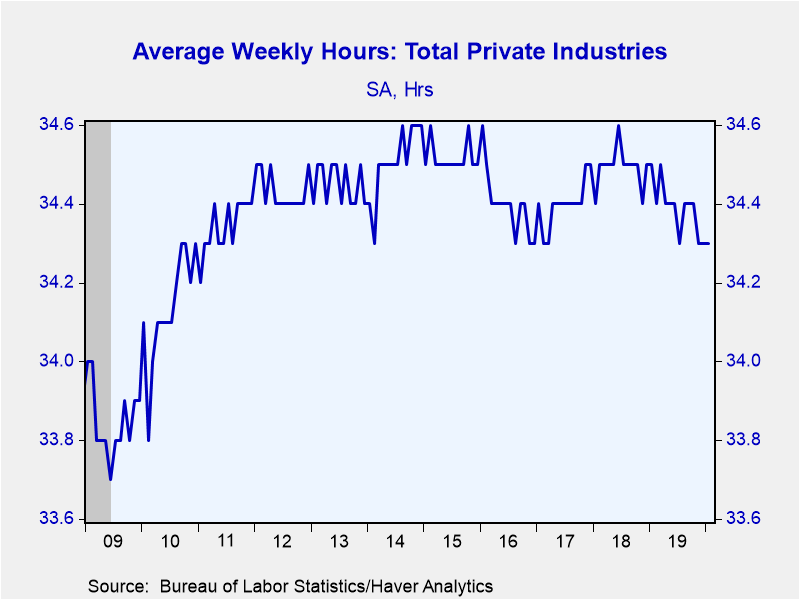 The length of the average workweek held steady at 34.3 hours
for the third consecutive month. That was below the June 2018 peak of 34.6
hours. Hours worked in the mining & logging sector fell to 45.6, down from
the April 2018 peak of 46.8. Factory sector hours held steady at 40.4, but they
too were below the April 2018 peak. Construction sector hours improved slightly
to 39.1, but also were reduced from earlier highs. Private service sector hours
held steady at a lessened 33.2 as financial sector hours rose slightly to 37.6.
Information sector hours held at 36.2. Education & health services hours
held at 33.0. Leisure & hospitality industry improved modestly to 25.9 but
remained below the 2015 peak of 26.3.
The length of the average workweek held steady at 34.3 hours
for the third consecutive month. That was below the June 2018 peak of 34.6
hours. Hours worked in the mining & logging sector fell to 45.6, down from
the April 2018 peak of 46.8. Factory sector hours held steady at 40.4, but they
too were below the April 2018 peak. Construction sector hours improved slightly
to 39.1, but also were reduced from earlier highs. Private service sector hours
held steady at a lessened 33.2 as financial sector hours rose slightly to 37.6.
Information sector hours held at 36.2. Education & health services hours
held at 33.0. Leisure & hospitality industry improved modestly to 25.9 but
remained below the 2015 peak of 26.3.
From the household survey of employment, the increased 3.6% unemployment rate and the 50,000 gain in the labor force reflected a higher labor force participation rate of 63.4%. That was increased from the September 2015 low of 62.4%. The teenage participation rate rose to 36.1%, and for those aged 20-24 it rose to 72.9%. For workers aged 25-54, the rate increased to a cycle high of 83.1%. For men in that age bracket, the rate edged higher to 89.3%. For women of that age, it surged to 77.0%, the highest rate since 2000 and up from an average 73.7% during all of 2015. For workers aged 55 & over, the participation rate remained at 40.3%, but still was increased from 30.0% in 1995. The employment/population ratio of 61.2%, up from 58.4% in 2011.
The teenage unemployment rate eased to 12.6%, well below the 25.9% averaged in 2010. The rate for workers aged 20-24 of 6.3% was lower than the 15.5% average in 2010. For workers aged 25-54, the rate of 3.0% was down from 8.6% in 2010. For those over 55, the jobless rate of 2.4% compared to 7.0% in 2010.
By educational attainment, unemployment of workers without a high school diploma was 5.5%. High school graduates without a college degree were 3.8% unemployed and those with some college but no degree were 2.8% without work. College graduates were 2.0% unemployed.
The labor market data are contained in Haver's USECON database. Detailed figures are in the EMPL and LABOR databases. The expectations figures are in the AS1REPNA database.
| Employment: (SA, M/M Change, 000s) | Jan | Dec | Nov | Jan Y/Y | 2019 | 2018 | 2017 |
|---|---|---|---|---|---|---|---|
| Payroll Employment | 225 | 147 | 261 | 1.5% | 1.4% | 1.6% | 1.6% |
| Previous Estimate | -- | 145 | 256 | -- | -- | -- | -- |
| Manufacturing | -12 | -5 | 58 | 0.3 | 1.2 | 2.0 | 0.7 |
| Construction | 44 | 11 | -2 | 2.4 | 2.8 | 4.6 | 3.6 |
| Private Service-Producing | 174 | 147 | 202 | 1.8 | 1.4 | 1.5 | 1.8 |
| Government | 19 | 5 | 14 | 0.7 | 0.6 | 0.5 | 0.4 |
| Average Weekly Hours - Private Sector | 34.3 | 34.3 | 34.3 | 34.5 | 34.4 | 34.5 | 34.4 |
| Private Sector Average Hourly Earnings (%) | 0.2 | 0.1 | 0.4 | 3.1 | 3.3 | 3.0 | 2.6 |
| Unemployment Rate (%) | 3.6 | 3.5 | 3.5 | 4.0 | 3.7 | 3.9 | 4.3 |
Tom Moeller
AuthorMore in Author Profile »Prior to joining Haver Analytics in 2000, Mr. Moeller worked as the Economist at Chancellor Capital Management from 1985 to 1999. There, he developed comprehensive economic forecasts and interpreted economic data for equity and fixed income portfolio managers. Also at Chancellor, Mr. Moeller worked as an equity analyst and was responsible for researching and rating companies in the economically sensitive automobile and housing industries for investment in Chancellor’s equity portfolio. Prior to joining Chancellor, Mr. Moeller was an Economist at Citibank from 1979 to 1984. He also analyzed pricing behavior in the metals industry for the Council on Wage and Price Stability in Washington, D.C. In 1999, Mr. Moeller received the award for most accurate forecast from the Forecasters' Club of New York. From 1990 to 1992 he was President of the New York Association for Business Economists. Mr. Moeller earned an M.B.A. in Finance from Fordham University, where he graduated in 1987. He holds a Bachelor of Arts in Economics from George Washington University.


